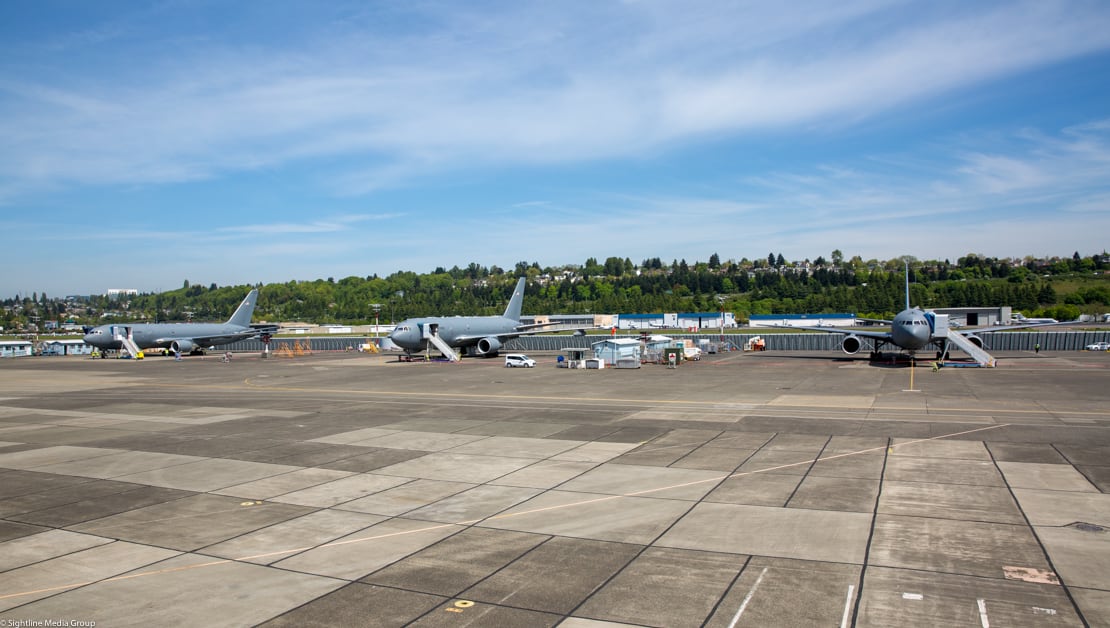WASHINGTON — After months of public — and sometimes contentious — disagreements, Boeing and the U.S. Air Force have finally settled on an October delivery date for the first KC-46 tanker.
“As a result of months of collaboration, the Air Force and Boeing KC-46A teams have reached an agreed joint program schedule to get to the first 18 aircraft deliveries. This includes the expectation the first KC-46A aircraft acceptance and delivery will occur in October 2018, with the remaining 17 aircraft delivered by April 2019,” Air Force Under Secretary Matt Donovan said in a statement.
“While the KC-46A flight test program is nearly complete, significant work remains. The Air Force is looking forward to KC-46A first delivery and will continue to work with Boeing on opportunities to expedite the program.”
The new schedule appears to be a compromise between Boeing and the Air Force’s estimated timelines. For months, Boeing has held that it could deliver its first KC-46 this summer, with a total of 18 tankers delivered this year.
The Air Force projections have been much more pessimistic, with first delivery at the end of the year, and 18 delivered by spring.
While it’s clear that Boeing will not meet the required assets available, or RAA, deadline — a contractual obligation to deliver 18 certified tankers and nine refueling pods — whether it will have to pay a penalty for being late is still murky. The company has already had to pay more than $3 billion in pretax charges on the program due to repeated schedule delays and technical issues.
Boeing has already missed its original RAA date, which was scheduled for August 2017, in addition to having to push back its first planned delivery a number of times.
“In partnership with the U.S. Air Force, our team has made great progress on the KC-46 tanker,” Boeing said in a statement. “With first delivery now set, the men and women of the Air Force know when they will start receiving this warfighting capability. The KC-46 is a top priority for The Boeing Company, and we have the best of Boeing working to ensure the U.S. Air Force gets their tankers as quickly as possible.”
The new schedule is the result of months of discussions between the aerospace giant and the service.
Top Air Force officials have recently made multiple visits to Boeing’s tanker production facilities near Everett in Washington state, including Chief of Staff Gen. Dave Goldfein, who traveled there earlier this month; Donovan; and Will Roper, its acquisition executive.
And while the agreement on schedule is a big victory for Boeing, which has been raked over the coals for its performance and overly optimistic approach, it still needs to prove itself by delivering the tankers on time.
That won’t be easy. The KC-46 currently has three outstanding category-1 deficiencies, the designation given to urgent technical problems with no workaround in place.
RELATED

Two of the deficiencies revolve around the system’s remote vision system, manufactured by Rockwell Collins. Unlike legacy tankers like the KC-135 and KC-10, where a boom operator can see the receiver plane as he steers the boom into the receptacle, the KC-46 boomer must completely rely on the RVS, a series of cameras and sensors.
However, in certain lighting conditions, the angle of the sun creates shadows and glares that make it difficult for the boom operator to properly see the receiver aircraft’s receptacle. That issue has resulted in another deficiency, where the boom scrapes the receiver aircraft without giving an indication to the boom operator that contact has occurred.
Boeing believes it can solve both problems with a software fix that retunes the camera system to increase visibility and to make it more intuitive for operators to change the camera settings. That fix is currently being tested with the hope that the deficiencies will be downgraded or completely eliminated in the next few months.
“We worked an enhancement, and what we were able to do through software is sharpen the image and the shadows get rid of the glare,” Mike Gibbons, Boeing’s program manager, told reporters in May. “We actually flew that for the first time in mid-March with the Air Force onboard. So they looked at it; they provided some additional commentary.”
Boeing’s expectation is that if they do not resolve the remote visioning system deficiencies, the Air Force will not accept the KC-46 this fall.
It’s unclear, however, whether the final category-1 deficiency will be fixed before first delivery. The issue involves a mechanical lock on the centerline drogue system, which unintentionally unlocks in certain conditions.
Boeing believes it can rectify the problem through a software fix but needs more flight test data to do so.
“It’s just [a matter of] when are we going to fix it,” Gibbons said in May. “We and the Air Force have agreed … for a while that the right time to do that is after we gather sufficient flight test information from some of these drogue contacts, go in and update the software, and then we’ll roll it in through the summer and test it out again.”
Valerie Insinna is Defense News' air warfare reporter. She previously worked the Navy/congressional beats for Defense Daily, which followed almost three years as a staff writer for National Defense Magazine. Prior to that, she worked as an editorial assistant for the Tokyo Shimbun’s Washington bureau.








